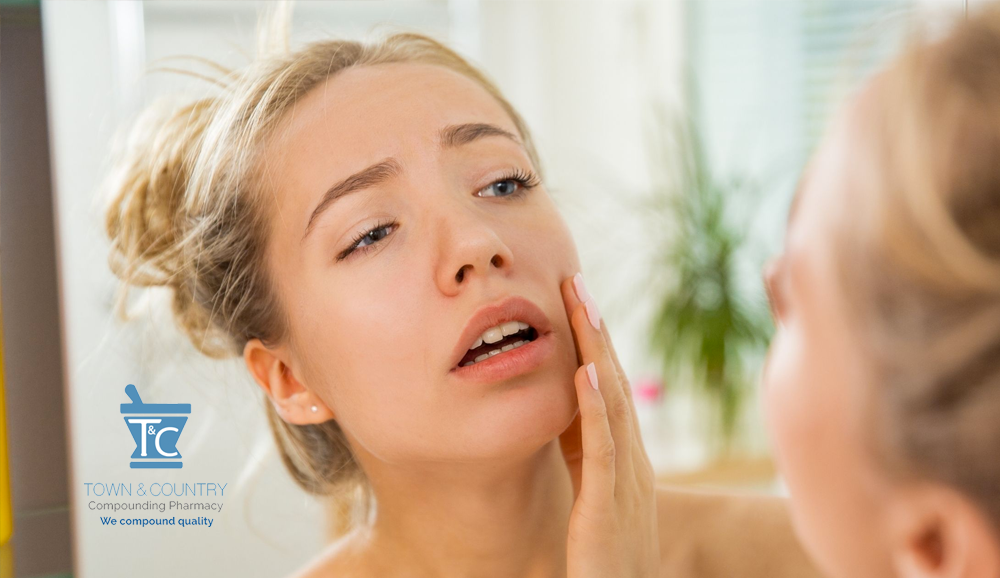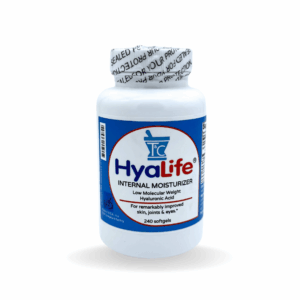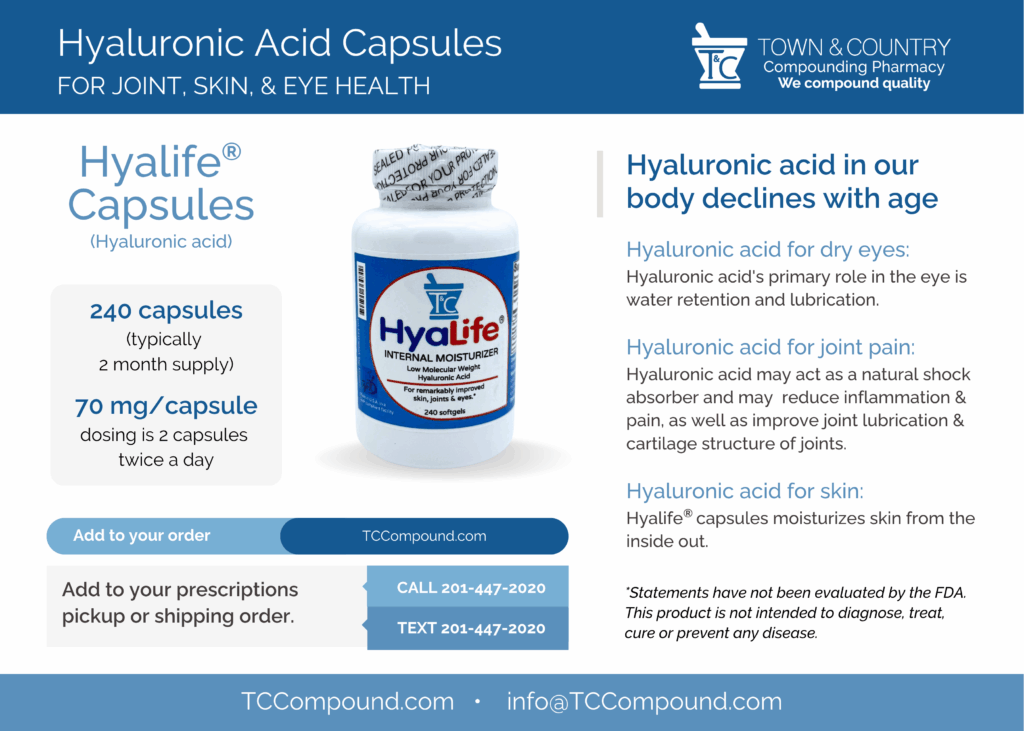A key component in skin moisture is hyaluronic acid also called hyaluronan.
It has the unique ability to bind and retain water molecules and holds many times its weight in water; various sources say up to 1000× its weight in water.
Age, Hyaluronic Acid, and the Skin
Hyaluronic acid is considered the ultimate internal moisturizer. It is present throughout the layers of the skin and acts like a sponge to hold moisture and keep the skin fresh and youthful looking.
As we age, the distribution of hyaluronic acid among the layers of the skin changes. Fetal epidermal tissues are rich in hyaluronic acid, which may be a reason why a baby’s skin recovers so quickly and often completely from injury.
However, as we get older, hyaluronic acid migrates downward through the layers of the skin, significantly decreasing in the upper layers of the epidermis, while levels increase in the lower layers of the dermis.
Therefore, in the epidermis, the skin that is visible to the world, moisture decreases due to the lower levels of hyaluronic acid causing the skin to look dull and wrinkled. Also, the hyaluronic acid that is present in the epidermis doesn’t stay there for very long. It has a half-life of less than 24 hours. Unless it is renewed constantly, things such as collagen and elastin can become brittle and lose their structural function.
“Hyaluronic acid is used to protect the eye during surgery, reduce inflammation in arthritis and joint pain, and to help prevent post-surgery scar tissue. Also referred to as hyaluronan, it has become commonly known in the cosmetic industry for plumping up facial wrinkles and lips.”
Soak in Moisture from the Inside-Out with Hyaluronic Acid Capsules (Hyalife®)
Skin, Eye, Joints
Hyalife® is a skincare nutraceutical that moisturizes from the inside out, helping your skin stay hydrated. It contains a clinically proven, low molecular weight hyaluronic acid gel complex, which acts as a sponge to hold onto water within the cells of the skin, connective tissue, and cartilage.
Hyaluronic Acid has been shown to be an essential component to healthy, youthful skin as well as support the health of joints and dry eyes.
Hyaluronic Acid: The Inside-Out Moisturizer
Hyaluronic acid is one of the main components of the gel-like medium that houses the cells of the connective tissue, cartilage, and skin, known as the extracellular matrix. It is found in substantial amounts in the skin; about 50% of the total amount of hyaluronic acid in the entire body is found in the skin. The epidermis acts as a barrier to the outside world, and hyaluronic acid strengthens that barrier. Hyaluronic Acid prevents bad elements, pathogens, and pollutants from penetrating the skin, and also keeps moisture in the skin. Hyaluronic Acid acts like a sponge to hold onto water within the skin, keeping it fresh and youthful-looking.
Easily Absorbed
Hyalife® is an easily absorbed, low molecular weight hyaluronic acid. Hyaluronic acid in its natural state is an extremely high molecular weight substance — measuring from 800,000 to 8,000,000 Daltons — that is too large for the body to absorb orally. As a result, it is simply excreted, unused.
Hyalife® has solved the hyaluronic acid absorption dilemma as it is manufactured through a patented enzyme-cleaving technique that reduces the molecular weight of hyaluronic acid without altering its chemical nature. Because of its small size, Hyalife® is easily orally absorbed.
The low molecular weight hyaluronic acid contained in Hyalife® is estimated to be between 1,500 and 5,000 Daltons — less than one percent of their original size. As a result, Hyalife® is absorbed easily through the intestinal tract.
Natural Source
Hyalife® is derived from rooster combs, which have been safely used as a source of hyaluronic acid for more than 20 years, in the form of an injectable treatment for osteoarthritis of the knee. Not only does this type of hyaluronic acid have a natural affinity for human tissues, it has been clinically shown not to cause an allergic response.
Delivered to the Skin
The absorption and delivery of Hyalife® has been used to measure wound healing capacity. Rats treated with oral Hyalife® experienced significantly improved wound healing compared to those given placebo, which seems to be a reliable indicator that Hyalife®2 is absorbed and delivered to the target tissue: the skin.
These statements have not been evaluated by the Food and Drug Administration.
This product is not intended to diagnose, treat, cure, or prevent any disease.
Refer to our Blog for more information:
Studies and References: Hyaluronic Acid and Wounds
Oral hyaluronan relieves wrinkles: A double-blinded, placebo-controlled study over a 12-week period
A 2017 study showed that oral Hyaluronic Acid for 12 weeks improved the skin’s luster and suppleness and reduced wrinkles in a group of healthy people in Japan aged 22–59 years old. Read on >>
Anti-wrinkle creams with hyaluronic acid: How effective are they?
Anti-aging effects of four different face creams containing hyaluronic acid demonstrated increased skin tightness and a 10–20% reduction in wrinkle depth in all study participants. Read on >>
The tricky tear trough: A review of topical cosmeceuticals for periorbital skin rejuvenation
Many cosmetic brands claim that their hyaluronic acid products can decrease wrinkles but many over-the-counter products contain hyaluronic acid molecules that are too large to pass through the epidermis. Molecules smaller than 500 kDa can be absorbed into the skin. However, large molecules (molecular weight > 500 kDa) cannot pass the barrier. A 2011 study showed that twice-daily application of Hyaluronic Acid at 50 and 130 kDa applied for 60 days to the periorbital region significantly decreased wrinkle depth. Read on >>
Everything you need to know about hyaluronic acid
Hyaluronic acid has a critical role in wound healing as it increases healing time by reducing inflammation and redirecting blood vessels to areas of skin that are damaged. Read on >>
Hyaluronic acid dressing (Healoderm) in the treatment of diabetic foot ulcer: A prospective, randomized, placebo-controlled, single-center study
A 2016 study showed that hyaluronic acid enhanced healing in diabetic foot ulcers and the study supported the safety and efficacy of a pure Hyaluronic Acid dressing without additional biologics. Read on >>
Effect of the hyaluronic acid‐poloxamer hydrogel on skin‐wound healing: In vitro and in vivo studies
A gel containing hyaluronic acid and poloxamer was applied to skin wounds. The gel promoted wound healing by preventing bacterial infections and moisturizing the wound. Read on >>



